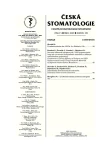Individual Titan-ceramic Extension
Authors:
J. Strecha 1; R. Jurkovič 2; T. Siebert 3; P. Prachár 4; S. Bartáková 4; E. Fojtíková 1
Authors‘ workplace:
Eurodent medima, s. r. o., Martin
1; Deimperio, s. r. o, . Bratislava
2; Dentálne centrum, s. r. o., Trnava
3; Stomatologická klinika LF MU a FN u sv. Anny, Brno
4
Published in:
Česká stomatologie / Praktické zubní lékařství, ročník 109, 2009, 5, s. 92-97
Overview
Prosthetic reconstruction on the implant represents an important chapter in the practice of implantology. The stability of function of the prosthetic substitution provides a reliable anti-rotation system of the extension part of the implant, which fixes the prosthetic work and transfers the mastication pressures through the implant to the surrounding bone. The shape of the extension part determines satisfying function and esthetics of the prosthetic work.
In the process of developing the shape of the Martikan system were gradually came to the conclusion that the ideal shape of the gingival part of the extension, especially in the visible part of the set of teeth can be reached only when it is made individually. In collaboration with the producer and dental technique the authors gradually developed technology of individually made titan-ceramic extension. In spite of the complex and time-consuming technology it has become possible to reach markedly better results in the esthetics and function of the prosthetic work.
Key words:
dental implant - individual extension - ceramic extension
Sources
1. Anderson, B., Glauber, R., Maglione, M., Taylor A.: Ceramic implant abutments for short-span FPDs: a prospective 5-year multicenter study. Int. J. Prosthodont., 16, 2003, 6, s. 640-646.
2. Anderson, B., Tailor, A., Lang, B. R., Schiller, H., Schärer, P., Sorensen, J. A., Tarnow, D.: Alumina ceramic implant abutments used for single-tooth replacement: a prospective 1- to 3-year multicenter study. Int. J. Prosthodont., 14, 2001, 5, s. 432-438.
3. Bombard, P., Hermans, M., Adriaenssens, P., Daelemans, P., Malevez, C.: Anterior esthetic rehabilitation on teeth and dental implants optimized with Procera technology: a case report. J. Esthet Restor Dent., 13, 2001, 3, s. 163-171.
4. Canullo, L.: Clinical outcome study of customized zirconia abutments for single-implant restorations. Int. J. Prosthodont, 20, 2007, 5, s. 489-493.
5. Cranham, J. C., Konikoff, A. B.: Maxillary anterior implant treatment: a protocol for aesthetic success. Dent. Today, 20, 2001, 3, s. 68-71.
6. Galindo, M. L., Hagmann, E., Marinello, C. P., Zitzmann, N. U.: Long-term clinical results with Procera AllCeram full-ceramic crowns. Schweiz Monatsschr Zahnmed., 116, 2006, 8, s. 804-809.
7. Glauber, R., Sailer, I., Wohlwend, A., Studer, S., Schibli., M., Schärer, P.: Experimental zirconia abutments for implant-supported single-tooth restorations in esthetically demanding regions: 4-year results of a prospective clinical study. Int. J. Prosthodont., 17, 2004, 3, s. 285-290.
8. Hagiwara, Y., Matsumura, H., Tahala, S., Woelfel, J. B.: Single tooth replacement using a modified metal-ceramic resin-bonded fixed partial denture: a clinical report. J. Prosthet Dent., 91, 2004, 5, s. 414-417.
9. Henriksson, K., Jemt, T.: Evaluation of custom-made procera ceramic abutments for single-implant tooth replacement: a prospective 1-year follow-up study. Int. J. Prosthodont., 16, 2003, 6, s. 626-630.
10. Heydecke, G., Sierraalta, M., Razzoog, M. E.: Evolution and use of aluminum oxide single-tooth implant abutments: a short review and presentation of two cases. Int. J. Prosthodont., 15, 2002, 5, s. 488-493.
11. Iglesia-Puig, M. A.: Custom-made laser-welded titanium implant prosthetic abutment. J. Prosthet Dent., 94, 2005, 4, s. 401-403.
12. Kerstein, R. B., Castellucci, F., Osočil, J.: Ideal gingival form with computer-generated permanent healing abutments. Compend Contin Educ. Dent., 21, 2000, 10, s. 793-797.
13. Kourtis, S. G.: Selection and modification of prefabricated implant abutments according to the desired restoration contour: a case report. Quintessence Int., 33, 2002, 5, s. 383-388.
14. Magne, P., Magne, M., Jovanovic, S. A.: An esthetic solution for single-implant restorations - type III porcelain veneer bonded to a screw-retained custom abutment: a clinical report. J. Prosthet Dent., 99, 2008, 1, s. 2-7.
15. Marchack, C. B., Yamashita, T.: A procedure for a modified cylindric titanium abutment. J. Prosthet Dent., 77, 1997, 5, s. 546-549.
16. Ormianer, Z., Schiroli, G.: Maxillary single-tooth replacement utilizing a novel ceramic restorative system: results to 30 months. J. Oral Implantol., 32, 2006, 4, s. 190-199.
17. Rimondini, L., Cerroni, L., Carrassi, A., Torricelli, P.: Bacterial colonization of zirconia ceramic surfaces: an in vitro and in vivo study. Int. J. Oral Maxillofac. Implants, 17, 2002, 6, s. 793-798.
18. Schiroli,G.: Single-tooth implant restorations in the esthetic zone with PureForm ceramic crowns: 3 case reports. J. Oral Implantol., 30, 2004, 6, s. 358-363.
19. Schneider, R.: Implant replacement of the maxillary central incisor utilizing a modified ceramic abutment (Thommen SPI ART) and ceramic restoration. J. Esthet Restor Dent., 20, 2008, 1, s. 21-27.
20. Tan, P. L., Dunne, J. T. Jr.: An esthetic comparison of a metal ceramic crown and cast metal abutment with an all-ceramic crown and zirconia abutment: a clinical report. J. Prosthet Dent., 91, 2004, 3, s. 215-218.
Labels
Maxillofacial surgery Orthodontics Dental medicineArticle was published in
Czech Dental Journal

2009 Issue 5
- What Effect Can Be Expected from Limosilactobacillus reuteri in Mucositis and Peri-Implantitis?
- The Importance of Limosilactobacillus reuteri in Administration to Diabetics with Gingivitis
Most read in this issue
- Cephalometric Analysis
- History and Etiology of Jawbones Osteonecrosis
- Comparison of Curing Efficacy of Halogen and LED Polymerization Lamps Using Composite Materials of Different Polymerization Mechanism
- Individual Titan-ceramic Extension
